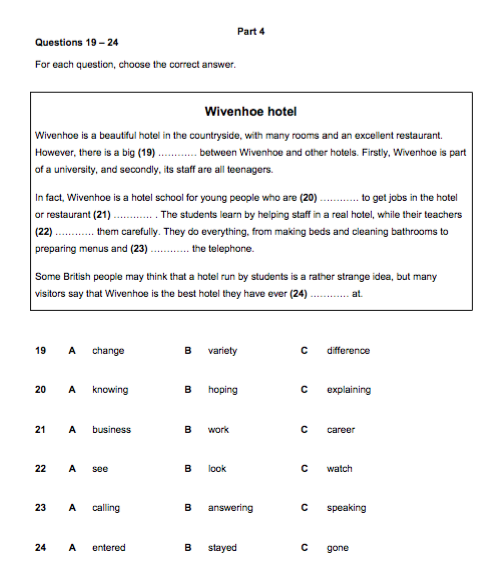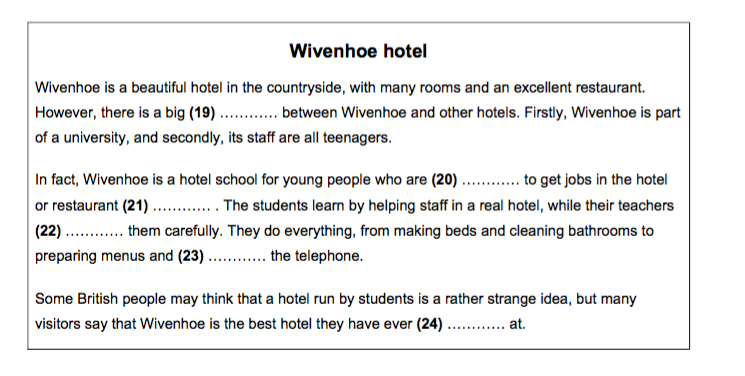About A2 Key Reading Part 4 and how to approach it
In today’s post, I’ll look at A2 Key Reading Part 4 and share some tips about how to do it.
Let’s take the sample task from the A2 Key for Schools Sample Paper, available for download here.
In Part 4 of the A2 Key (and Key for Schools) Reading and Writing test, candidates read a short, factual text with six gaps.
For each gap, there are three options to choose from. Each option is one word.
All three options come from the same word class (mainly nouns or verbs). Four or five questions focus on lexis and one or two on grammar.
There are six marks available.
Important to know:
- Four or five questions focus on lexis and one or two on
- Collocation and differences in meaning are key factors here.
Tips for doing this part
1 Read the title
The title is usually simple and concise. Here, we know that the text is about a hotel. Wivenhoe is a name. It could be a place perhaps, but that doesn’t matter.
2 Read the whole text
Students should read the whole text through first. It’s tempting to start completing the gaps, but reading the text till the end is important. This will give students an idea of the content and the structure and development of the text.
As this is a factual text, the verbs are usually in the present simple, as they are here.
3 Think of your own ideas for the gaps
Even at A2 level, words will come to mind for some of the gaps. My advice is always to trust your instinct, what sounds ‘right’. Then, compare your ideas with the options. Sometimes, the word will be there.
4 Look before and after the gaps
Words before the gap (like determiners) and words after it (like prepositions) can often make one option right and another option wrong.
e.g. 22 B is wrong – because you look at something or someone. C is right because watch doesn’t need a preposition after it (and it’s a longer, more focused activity than A see).
5 Consider why options are wrong
Sometimes, students can’t think why an option is right (although as I said above, they should trust their instincts). Maybe they can spot why an option is wrong (e.g. look is wrong in 22 because you look at something).
6 Read the sentences with the gaps (and the whole text) ‘aloud’
If students ‘hear’ the sentence with the gap ‘aloud’ (in their head – they can’t speak in the exam!), the right option will usually ‘sound’ right. (And the wrong options will ‘sound’ wrong! (*Thanks to Anna Karanikola for reminding me about this tip!)
7 Always choose an answer – even if you’re not sure
Let’s look at each question and why options are wrong or right.
19 A change B variety C difference
Option C – difference – is the correct answer here. The preposition ‘between’ after the gap makes this clear (after change we use the preposition in and after variety we use of) C is also the correct option because of meaning. A change is something different happening after a certain point.
20 A knowing B hoping C explaining
B is the correct answer. Again, the preposition (to) which follows the gap makes this the right option. You explain something. knowing is an interesting option, as we don’t usually use that verb in the ‘ing’ form!
21 A business B work C career
A is the correct answer. This question is testing collocation. ‘restaurant business’ here means that area of activity. Work and career are related to the things that people do or have.
22 A see B look C watch
C is the correct answer. ‘Watch’ implies doing things for longer, and carefully, as this sentence says. ‘See’ is usually for shorter times, or something you see by accident. And ‘look’ requires the preposition ‘at’ afterwards.
23 A calling B answering C speaking
B is the correct answer. You ‘answer the telephone’, you ‘call’ someone (or a number) and you ‘speak’ on the phone (or to someone).
24 A entered B stayed C gone
B is the correct answer. You ‘stay at’ a hotel. You ‘enter’ a place (go through the entrance) and you go to’ a hotel, so the preposition isn’t right.
7 Write the words in the gaps
If students are taking the paper version of A2 Key, then I’d always tell them to write the words that they have chosen in the gaps and read it through. Seeing it in context can help them to spot wrong choices.
8 Transfer your answers when you have completed the task
Tell students to transfer their answers for this Part to the answer sheet, BUT ONLY WHEN THEY HAVE COMPLETED THE TASK. (If they write their answers straight onto the answer sheet, they may make a mistake and circle the letter for a different answer, especially if they have not chosen an answer for one of the middle gaps).
In my next post, I’ll share some ideas for further work on this text, the language and the topic.



